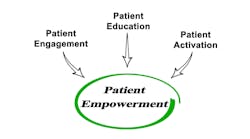Kaufman Hall’s Crnkovich: Millennials’ Demands Will Force Health System Change
This week, the leaders of the Chicago-based Kaufman Hall consulting firm released a new report on the healthcare consumer experience, focusing on the needs and desires of millennials. “How Millennials Are Reshaping Healthcare’s Future,” by managing director Paul Crnkovich and senior vice president Dan Clarin of Kaulfman Hall, speaks to some of the challenges facing the leaders of traditional patient care organizations—hospitals, medical groups, and health systems.
As the report’s introduction notes, “For years, healthcare leaders have hypothesized about the changes the tech-savvy, instant messaging Millennial generation would bring to the industry—but the time for speculation is past. The oldest Millennials are well into their 30s, and already are driving significant change in healthcare as they make care decisions for themselves, their young children, and increasingly, their aging parents. Hospitals and health systems must act now to reshape their business models to address rising demands from this surging generation, particularly as it pertains to routine care. Born from the early 1980s to the mid-1990s, Millennials range in age from the early 20s to the mid- to late-30s, and recently surpassed Baby Boomers as the largest population segment at 73 million.”
Among the issues the report address: the unique characteristics of the millennial generation that are making it such a significant force for healthcare change; recent Kaufman Hall consumer research results that provide insights into millennials’ healthcare behaviors; and important steps healthcare organizations should take to adapt to changing consumer demands.
Demographics matter. As Crnkovich and Clarin note, “Millennials’ healthcare spending is significant and growing. Combined with other young adults, they make up about 34 percent of the population and contribute about 21 percent of total healthcare spending. While older generations continue to be the biggest users of healthcare services, Millennials are changing expectations across the industry with greater demands for improved healthcare access, value, and consumer experience.”
What’s more, the authors note, “Millennials’ influence will only grow as they get older and comprise a greater proportion of healthcare demand. Look at the incidence of those with more than one chronic condition, for example, as these individuals historically are high healthcare users. While only 28 percent of those ages 25-34 have more than one chronic condition, the proportion steadily rises to 80 percent or more for individuals ages 65 and older.”
Among other elements, the authors recommend that, “To meet the new demands of Millennials and other young adults, healthcare providers should start with a basic question: Why will consumers choose you, and why will they come back to you? Addressing that question requires a fundamental shift in mindset and business model. Legacy providers must transition from an internal, hospital-centric emphasis on efficiency, to an external focus on capturing consumer demand. It’s not about ‘satisfying’ consumers—rather it’s about ‘delighting’ them by exceeding their expectations for convenience, service, and value. Doing so will drive new patient growth and increase patient loyalty, and result in improved financial performance.” And, they add, “Effective solutions should be grounded in what Kaufman Hall refers to as the ‘Big 3 + 1.’ These include access, experience, and pricing, all supported by and grounded in a solid infrastructure of leadership, branding, insights, analytics, and digital strategy.”
Shortly after the release of the report, co-author Paul Crnkovich spoke with Healthcare Innovation Editor-in-Chief Mark Hagland, about its findings and analysis. Below are excerpts from that interview.
The healthcare system has been very provider-centric, not consumer-centric, right?
You’re exactly right. I was in the consumer products industry, was at Quaker Oats, Gatorade, in pet foods, and by definition, in consumer products, the consumer’s at the center of your business; if not, you’re out of business. When I first came into healthcare, what came into mind was a factory, with everything focused on physicians, and optimized like a conveyor belt. It’s like the security line at O’Hare: imagine patients as being bins pushed along.
And every aspect of our lives is becoming more and more on-demand. If you listen to Bezos, he has an obsession with the consumer. He isn’t worried about the competitors, he’s focused on the consumer. I ran a consulting firm focused on consumer behavior. And some of my clients would ask, “How are we going to compete against Amazon?” And I would tell them, you know, Bezos never asks how he’ll compete against you.” And now, with routine primary care, non-emergent, you have multiple choices. And this is where you’re going to see the biggest disruption first, simply because I can access everything on my phone, and have a bunch of potential providers who understand what I want. And I have three of my own millennials, and the way they’re interacting with the healthcare system is totally different. And especially among Generation Zs, they’re the ultimate digital natives.
Should the leaders of traditional patient care organizations take note of the Aetna-CVS merger, and the combined company’s potential to be a real disruptor in terms of providing convenient primary care services in CVS stores?
Yes, I agree 1,000 percent. And that new primary care model they’re creating, is a tactical solution for addressing a bigger question, which is, what is the consumer need-state we’re going after? I’ve got sinusitis or a sore throat, and I need to see someone right away. 24/7 on-demand care is the answer, through multiple modalities: that’s how we define access. You have the ability, at any time, to go to a walk-in clinic, or go online and do an online telehealth visit; or you could try to make an appointment and see your PCP in six days. And so often, the industry misses the whole point, which is, let’s look at what consumer segment whose needs we’re addressing, what are their needs and wants, and how do I make sure the consumer can get that care through me? Because if I don’t offer that service, there is no loyalty among those consumers; a big chunk of them don’t even have a PCP.
Would you say that traditional loyalty on the part of patients towards hospitals and medical groups, is gone now?
It’s morphing into different dimensions. Basic consumer marketing research looks at segmenting populations by attitude. There will always be a certain segment of consumers who are loyal, but that’s changing. Most people are still loyal, if at all, to an individual doctor, and maybe a local individual hospital. So I think what you’re going to find is, as consumers are now responsible for a greater portion of the cost, and they also have technology and other options, loyalty will break into segments.
For urgent needs for minor care, people will have loyalty to who can get me in and out quickest. I’ll give you a 10-out-of-10 net promoter score. So loyalty may be more towards a site of care or experience, as opposed to a specific doctor or patient care organization. And that’s something people haven’t quite figured out fast.
Our view is that health systems and providers will have to win on every transaction; it’s going to be a jump ball every time. It’s about what we call targeted brand value: for a given service, what are the most important elements for the consumer? For urgent care, it’s very clear that it’s, get me in and out fast. And if it’s a brand-name provider’s name over the door, maybe that might add a bit of perceived value, but if it’s going to be a 90-minute wait, forget it.
We’re reaching the point where healthcare systems are going to have to break themselves up into two really different businesses. There’s tertiary and quaternary care, where the focus will be on excellence, along with running leaner as a factor. But everything’s shifting to outpatient, and it can’t be about making incremental improvements to my HOPD [hospital outpatient department] facility, but really, rethinking things. When it comes to walk-in clinics and urgent care facilities, no enterprise can do everything well, and I would argue that you’ll do much better expanding your services through a skilled walk-in clinic provider.
New York-Presbyterian has had huge success with their creating a telehealth unit literally next to their ED, offering convenience for those with non-urgent conditions like sore throats and flu, and reducing wait times in their main ED; the service is triaged by nurses, and has been very successful.
I’m sure you’ve heard the three Ps of marketing: we say, the right procedure in the right place, at the right price. We’re helping the consumer coming into the ED, we’re enabling them by giving them options. What’s the first thing you think of when you go into the ED? How long will I have to wait? And how much will it cost? So yes, that’s a great example of saying, we need to help educate consumers as to the right place to go for care. Symptom checkers and chat bots that will help you on your phone to direct you to the right site of care, whether ED or urgent care, etc. That’s a great use of technology: you’re empowering the consumer. You’ve told them, hey, this isn’t that serious, and you could wait, but what you have, we think, can be handled through a nurse practitioner—go to a kiosk, it’ll only cost you $30, and you’ll be out of here in ten minutes. It’s a great example of lowering costs and improving satisfaction.
What will happen in the next five years?
I think we are getting to an inflection point where the traditional legacy providers have to rethink non-emergent care, that that’s going to have to be thought of as a completely different business, and it starts with looking at different segments of consumers. And you’ll have to be able to provide 24/7 on-demand care. Some of it you’ll do on your own, some through partnerships. But you’re touching most of the people most of the time, in the outpatient setting. And if you don’t have a consumer-centric network at the center, you’ll be losing customers. That’s going to be a requirement, and organizations will be moving at varying speeds to get there. I think the industry will move slowly, and some of those services will be pulled away by disruptors who are set up to deliver those services. Convenience, access, and other elements will be important. At the end of the day, it comes back to a two-part question: why is Consumer X going to come to you, and why will they come back? They’ll come to you based on access, on a variety of terms, and then they’ll come back, because you’ve satisfied their needs.
Is there anything you’d like to add?
I know this has been said a lot, but the pace of change is rapidly accelerating. And there are real implications around that for real capital and financial planning decisions today. We may be planning that 50 percent of our routine-care visits are going to be virtual in five years. Well, five years isn’t very long in hospital system terms. So if I’m building new towers, they may be ready just in time for my not needing them. There’s a 260-bed hospital system, very progressive and forward-looking, and their anchor facility needed to be replaced; and they decided to replace that 260-bed facility with a 90-bed facility. Show me a hospital system today planning to do that. And in this case, it wasn’t because the population was decreasing; the opposite. They’re looking towards in-home care, telehealth, etc. They felt they had to use their financial planning wisely.


